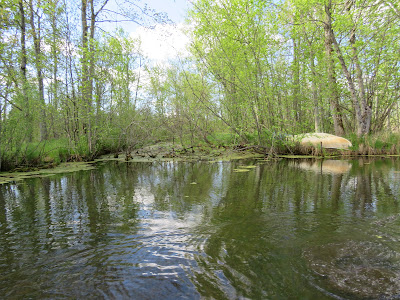Little over a year ago, Dave Shepherd and I were halted by fallen trees in our attempt to access Chippewa Watershed Conservancy’s 3-acre, Riverbank Preserve by canoeing on the south Branch of the Pine River west from the Rolland Rd. bridge in Isabella County. Under sunny skies with mid-morning temperatures in the mid 50’s, a stiff north wind and Dave’s chainsaw, we try again. Before heading out, I notice a pile of branches that were first cut and gathered by beaver to dam up the road culvert and later removed by workers to prevent flooding of the roadway. Moving slowly upstream through a narrow, greening riverscape, we perk up to the sound of a Yellowthroat and the sight of what appears to be a perching Willow Flycatcher. Flycatchers don’t learn their songs from their parents, as many other birds do. Instead they hatch knowing their songs. Scientists tested this by raising Willow Flycatchers in captivity while letting them listen to an Alder Flycatcher sing its song. Despite hearing only this song all day, Willow chicks grew up to sing their own song. After Dave clears away a large branch, we move ahead where I notice that the floating florae include, Wooly algae and a mixture of Curly-leaf Pondweed, Narrow-leaf Pondweed and Duckweed. Near shore, I spot flowering Pennsylvania Sedge and sprouting cattail shoots. After about a half mile, we paddle through an extreme meandering section of the river that makes up the Riverbank Preserve where I look skyward to see a perching Tree Swallow and look near shore to see a basking Blanding’s Turtle, distinguished by its helmetlike shell and mustard-yellow throat. Though not listed as an endangered species, it is one of special concern in Michigan where its habitats have been fragmented by roads and development. Pioneer physician William Blanding first stumbled onto this beautiful turtle while exploring the Fox River in Illinois in 1830. His pickled specimen still resides in the collections of the Philadelphia Academy of Natural Sciences. In 1838, herpetologist John Holbrook published its formal description, which included this statement: “first observed by Dr. William Blanding of Philadelphia, an accurate naturalist, whose name I have given this species.” Turning around to head back, we take a narrow side channel northward that curves into a wide, oxbow-like lake where I spot a pair of perching Yellow Warblers and an active nest of a Canada Goose containing 6, 3-inch white eggs. Turning around again, we paddle back to the car, pleased to have finally explored this remote, scenic preserve.
From a very hectic pace
To calm and quiet place
From acres of concrete
To a riparian retreat
From busy urban scene
To verdant meadow green
From over-crowded rooms
To fields of colored blooms
From loud sirens sound
To birdsongs surround
When life cages you and me
Mother Nature sets us free
D. DeGraaf

No comments:
Post a Comment